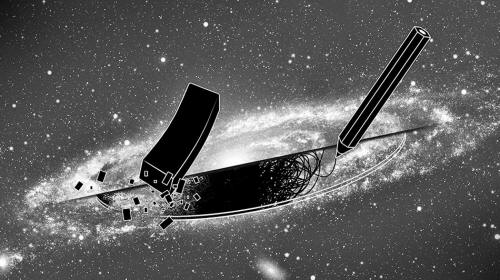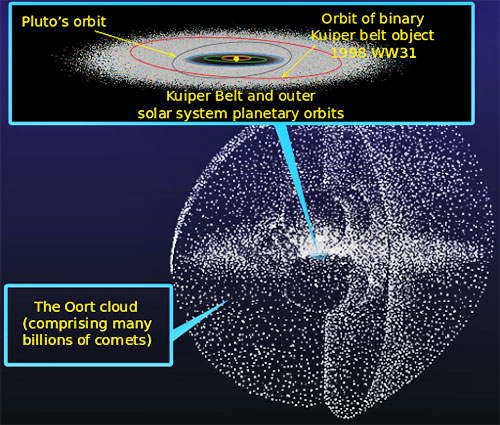|
from
QuantaMagazine Website
the controversial idea that dark matter is concentrated in thin disks
is being rescued from
scientific oblivion.
Judging by the way the stars bob up and down like horses on a carousel as they go around the plane of the galaxy, Oort calculated that there ought to be twice as much matter gravitationally propelling them as he could see.
He postulated the presence of hidden
"dark matter" to make up the difference and surmised that it must be
concentrated in a disk to explain the stars' motions.
Oort is passed over on the grounds that he was trailing a false clue.
By 2000, updated, Oort-style inventories of the Milky Way determined that its "missing" mass consists of faint stars, gas and dust, with no need for a dark disk. Eighty years of hints suggest that dark matter, whatever it is, forms spherical clouds called "halos" around galaxies. Or so most dark matter hunters have it.
Though it fell out of favor, the dark disk idea never completely went away.
And recently, it has found a high-profile champion in Lisa Randall, a professor of physics at Harvard University, who has rescued the disk from scientific oblivion and given it an active role on the galactic stage.
Since proposing the model (Double-Disk Dark Matter) in 2013, Randall and her collaborators have argued that a dark disk might explain gamma rays coming from the galactic center, the planar distribution of dwarf galaxies orbiting the Andromeda galaxy and the Milky Way, and even periodic upticks of comet impacts and mass extinctions on Earth, discussed in Randall's 2015 popular-science book, Dark Matter and the Dinosaurs.
But astrophysicists who do inventories of the Milky Way have protested, arguing that the galaxy's total mass and the bobbing motions of its stars match up too well to leave room for a dark disk.
Now, Randall, who has devised influential ideas about several of the biggest questions in fundamental physics, is fighting back.
In a paper posted online last week (Updated Kinematic Constraints on a Dark Disk) that has been accepted for publication in The Astrophysical Journal, Randall and her student, Eric Kramer, report a disk-shaped loophole in the Milky Way analysis:
Rose Lincoln/Harvard University Lisa Randall of Harvard University is a high-profile supporter of the controversial dark disk idea.
If there is a thin dark disk coursing through the "midplane" of the galaxy, Randall and Kramer argue, then it will gravitationally pinch other matter inward, resulting in a higher density of stars, gas and dust at the midplane than above and below.
Researchers typically estimate the total visible mass of the Milky Way by extrapolating outward from the midplane density; if there's a pinching effect, then this extrapolation leads to an overestimation of the visible mass, making it seem as if the mass matches up to the stars' motions.
He and Randall find that a thin dark disk is possible - and in one way of redoing the analysis, slightly favored over no dark disk.
Bovy disagrees.
Even taking the pinching effect into account, he estimates that at most 2 percent of the total amount of dark matter can lie in a dark disk, while the rest must form a halo.
The debate - and the fate of the dark disk - will probably be decided soon.
The European Space Agency's Gaia satellite is currently surveying the positions and velocities of one billion stars, and a definitive inventory of the Milky Way could be completed as soon as next summer.
The discovery of a dark disk, of any size, would be enormously revealing. If one exists, dark matter is far more complex than researchers have long thought. Matter settles into a disk shape only if it is able to shed energy, and the easiest way for it to shed sufficient energy is if it forms atoms.
The existence of dark atoms would mean dark protons and dark electrons that are charged in a similar style as visible protons and electrons, interacting with each other via a dark force that is conveyed by dark photons.
Even if 98 percent of dark matter is inert, and forms halos, the existence of even a thin dark disk would imply a rich "dark sector" of unknown particles as diverse, perhaps, as the visible universe.
The notion that dark matter might be complex has gained traction in recent years, aided by astrophysical anomalies that do not gel with the long-reigning profile of dark matter as passive, sluggish "weakly interacting massive particles - WIMPs."
These anomalies, plus the failure of "WIMPs" to show up in exhaustive experimental searches all over the world, have weakened the WIMP paradigm, and ushered in a new, free-for-all era, in which the nature of the dark beast is anybody's guess.
The field started opening up around 2008, when an experiment called PAMELA detected an excess of positrons over electrons coming from space - an asymmetry that fueled interest in "asymmetric dark matter," a now-popular model proposed by Kathryn Zurek and collaborators.
At the time, there were few ideas other than WIMPs in play.
Jonathan Alcorn for Quanta Magazine James Bullock of the University of California, Irvine, sees dark matter as potentially complex and self-interacting, but not necessarily concentrated in thin disks.
Another trigger has been the density of dwarf galaxies.
When researchers try to simulate their formation, dwarf galaxies typically turn out too dense in their centers, unless researchers assume that dark matter particles interact with one another via dark forces.
Add too much interactivity, however, and you muck up simulations of structure formation in the early universe.
Most modelers add weak interactions that don't affect the halo shape of dark matter.
But "remarkably," James Bullock said,
In that case, only a tiny fraction of dark matter particles interact, but they do so strongly enough to dissipate energy - and then form disks.
Randall and her collaborators JiJi Fan, Andrey Katz and Matthew Reece made their way to this idea in 2013 by the same path as Oort: They were trying to explain an apparent Milky Way anomaly.
Known as the "Fermi line," it was an excess of gamma rays of a certain frequency coming from the galactic center.
The dark disk was reborn.
The Fermi line vanished as more data accumulated, but the disk idea seemed worth exploring anyway. In 2014, Randall and Reece hypothesized that the disk might account for possible 30- to 35-million-year intervals between escalated meteor and comet activity, a statistically weak signal that some scientists have tentatively tied to periodic mass extinctions.
Each time the solar system bobs up or down through the dark disk on the Milky Way carousel, they argued, the disk's gravitational effect might destabilize rocks and comets in the Oort cloud - a scrap-yard on the outskirts of the solar system named for Jan Oort.
These objects would go hurtling toward the inner solar system, some striking Earth.
But Randall and her team did only a cursory - and incorrect - analysis of how much room there is for a dark disk in the Milky Way's mass budget, judging by the motions of stars.
Randall, who stands out (according to Reece) for "her persistence," put Kramer on the case, seeking to address the critics and, she said, "to iron out all the wrinkles" in the analysis before Gaia data becomes available.
Her and Kramer's new analysis shows that the dark disk, if it exists, cannot be as dense as her team initially thought possible.
But there is indeed wiggle room for a thin dark disk yet, due both to its pinching effect and to additional uncertainty caused by a net drift in the Milky Way stars that have been monitored thus far.
Now there's a new problem, raised in The Astrophysical Journal by Chris McKee of the University of California, Berkeley, and collaborators. McKee concedes that a thin dark disk can still be squeezed into the Milky Way's mass budget. But the disk might be so thin that it would collapse.
Citing research from the 1960s and '70s, McKee and colleagues argue that disks cannot be significantly thinner than the disk of visible gas in the Milky Way without fragmenting.
Randall has not yet parried this latest attack, calling it "a tricky issue" that is "under consideration now." She has also taken on the point raised by Bovy - that a disk of charged dark atoms is irrelevant next to the nature of 98 percent of dark matter.
She is now investigating the possibility that all dark matter might be charged under the same dark force, but because of a surplus of dark protons over dark electrons, only a tiny fraction become bound in atoms and wind up in a disk.
In that case, the disk and halo would be made of the same ingredients,
The dark disk survives, for now - a symbol of all that isn't known about the dark side of the universe.
|





